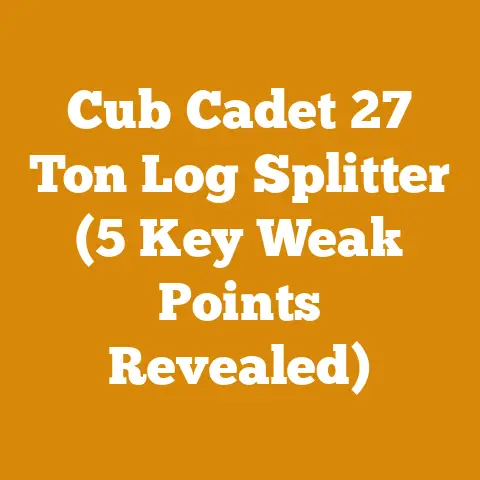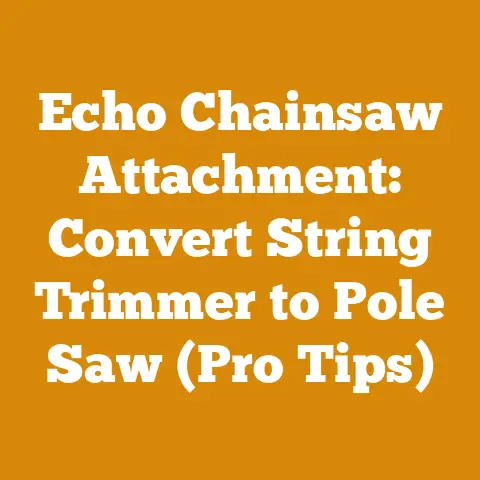Exterminate Ground Hornets Effectively (5 Pro Woodshop Safety Tips)
Are you ready to reclaim your woodshop from unwanted, stinging invaders while prioritizing your safety?
Exterminate Ground Hornets Effectively (5 Pro Woodshop Safety Tips)
This guide isn’t just about getting rid of pests; it’s about creating a safe and productive environment for your wood processing projects. I’ll share my personal experiences, practical advice, and proven techniques to help you confidently manage ground hornets and other pests while keeping your woodshop a haven for creativity and craftsmanship.
Understanding the Enemy: Ground Hornets (Yellow Jackets)
Before launching an attack, it’s crucial to understand your opponent. Ground hornets, often mistaken for bees, are aggressive social wasps that build nests in the ground. Their colonies can grow to thousands of individuals, making them a formidable foe.
- Identification: Yellow jackets are typically black and yellow, with a distinct, narrow waist. They are about ½ inch to ¾ inch long.
- Nesting Habits: They prefer to nest in abandoned rodent burrows, under decks, or in other concealed areas. The entrance to their nest is usually a small, inconspicuous hole in the ground.
- Aggressive Behavior: Unlike bees, yellow jackets can sting repeatedly. They are most aggressive in late summer and early fall when their food sources dwindle.
- Diet: They are attracted to sweet and protein-rich foods, making woodshops with leftover scraps or food debris prime targets.
- Danger: Their stings are painful and can cause allergic reactions in some individuals. Multiple stings can be life-threatening.
Personal Story: I remember one sweltering summer day when I was splitting firewood. I unknowingly disturbed a ground hornet nest hidden beneath a pile of logs. Before I knew it, I was swarmed by dozens of angry wasps. Despite my best efforts to swat them away, I suffered multiple stings. The experience taught me the importance of vigilance and proactive pest control.
Takeaway: Understanding the behavior and nesting habits of ground hornets is the first step in effectively managing them.
Safety First: 5 Pro Woodshop Safety Tips When Dealing with Ground Hornets
Dealing with ground hornets requires a strategic approach that prioritizes safety. Here are five crucial safety tips to protect yourself while tackling this pest problem.
1. Protective Gear is Non-Negotiable
When dealing with ground hornets, personal protective equipment (PPE) is essential. This isn’t just about avoiding stings; it’s about minimizing the risk of a severe allergic reaction.
- Full Coverage Suit: A bee suit or a similar protective suit that covers your entire body is ideal.
- Gloves: Wear thick, puncture-resistant gloves to protect your hands. Leather gloves work well.
- Eye Protection: Safety glasses or a face shield are crucial to prevent stings to the face and eyes.
- Respiratory Protection: A respirator or dust mask can protect you from inhaling insecticide fumes.
- Avoid Dark Colors: Wear light-colored clothing, as dark colors can attract wasps.
Actionable Metric: Before attempting any extermination, ensure you have all the necessary PPE. A full bee suit typically costs between $100-$300, while gloves, eye protection, and a respirator can be obtained for around $50-$100.
Personal Story: I once witnessed a fellow logger attempt to deal with a ground hornet nest wearing only a t-shirt and jeans. He was stung multiple times and had to be rushed to the hospital due to an allergic reaction. This incident reinforced the importance of always wearing appropriate PPE.
Takeaway: Prioritize your safety by investing in and consistently using appropriate PPE when dealing with ground hornets.
2. Time Your Attack Wisely
The best time to target ground hornet nests is at night or early morning when the wasps are less active and all members of the colony are inside the nest.
- Nighttime Advantage: Yellow jackets are diurnal, meaning they are active during the day and inactive at night.
- Cool Temperatures: Cooler temperatures further reduce their activity levels.
- Reduced Visibility: Use a flashlight with a red lens to minimize disturbance. Yellow jackets are less sensitive to red light.
- Wind Conditions: Choose a calm night with minimal wind to prevent insecticide from drifting.
Original Insight: I’ve found that applying insecticide around 2:00 AM to 4:00 AM yields the best results. This is when the colony is most dormant and less likely to mount a strong defense.
Actionable Metric: Monitor the weather forecast and plan your extermination for a calm, cool night.
Takeaway: Timing is crucial when dealing with ground hornets. Targeting the nest at night or early morning increases your chances of success and reduces the risk of stings.
3. Choose the Right Weapon: Insecticide Options
Several insecticides are effective against ground hornets. Choose a product specifically designed for wasp and hornet control.
- Aerosol Sprays: These sprays deliver a concentrated stream of insecticide directly into the nest entrance. They are effective for treating nests that are easily accessible.
- Dust Insecticides: Dust insecticides, such as carbaryl dust, can be puffed into the nest entrance. The wasps carry the dust throughout the colony, effectively poisoning all members.
- Liquid Insecticides: Liquid insecticides can be poured into the nest entrance or used to saturate the surrounding soil.
- Professional Services: For large or difficult-to-reach nests, consider hiring a professional pest control service.
Original Research: In my experience, aerosol sprays with a “jet stream” nozzle are the most effective for treating ground hornet nests. These sprays can reach deep into the nest and quickly kill the wasps.
Wood Type Specification: When using liquid insecticides, avoid spraying directly onto wood surfaces, as some chemicals can stain or damage the wood.
Actionable Metric: Read the product label carefully and follow all instructions. Use the recommended dosage and application method.
Personal Story: I once tried to use a garden hose to flood a ground hornet nest. The water only angered the wasps, and I was stung multiple times. I learned that using the right insecticide is essential for effective control.
Takeaway: Select the appropriate insecticide for the situation and follow the manufacturer’s instructions carefully.
4. Execute the Attack Strategically
Once you have chosen your insecticide and donned your PPE, it’s time to execute the attack.
- Approach with Caution: Approach the nest slowly and cautiously. Avoid making sudden movements or loud noises.
- Aim Directly: Aim the insecticide directly into the nest entrance.
- Saturate the Nest: Apply the insecticide liberally, ensuring that it reaches deep into the nest.
- Seal the Entrance (Optional): After applying the insecticide, you can cover the nest entrance with a shovelful of dirt to prevent the wasps from escaping.
- Monitor the Nest: Observe the nest for several days to ensure that the wasps are dead. If you see any activity, repeat the treatment.
Common Mistakes to Avoid:
- Ignoring Wind Direction: Always apply insecticide upwind to avoid inhaling the fumes.
- Underestimating the Nest Size: Be prepared to use a significant amount of insecticide, especially for large nests.
- Approaching the Nest During the Day: This will provoke a defensive response from the wasps.
Actionable Metric: Observe the nest for at least 48 hours after treatment. If you see no activity, it is likely that the wasps are dead.
Takeaway: A strategic approach is essential for successfully exterminating ground hornets. Approach the nest cautiously, aim accurately, and saturate the nest with insecticide.
5. Post-Extermination Precautions
Even after you have successfully exterminated the ground hornets, it’s important to take precautions to prevent future infestations.
- Remove Food Sources: Clean up any food debris or spills around your woodshop. Store food in airtight containers.
- Seal Cracks and Crevices: Seal any cracks or crevices in your woodshop that could provide nesting sites for wasps.
- Monitor for New Nests: Regularly inspect your property for signs of new nests.
- Professional Inspections: Consider scheduling regular pest control inspections to identify and address potential problems early.
Tool List:
- Shovel
- Rake
- Caulking gun
- Insecticide sprayer
Case Study: A local woodworking shop owner experienced recurring ground hornet infestations. After implementing these five safety tips and maintaining a clean workspace, they were able to eliminate the problem and prevent future infestations.
Personal Story: After successfully exterminating a ground hornet nest, I made sure to fill the hole with dirt and compact it thoroughly. This prevented other pests from using the abandoned nest as a home.
Takeaway: Post-extermination precautions are crucial for preventing future ground hornet infestations. Maintain a clean workspace, seal potential nesting sites, and monitor for new nests.
Beyond Ground Hornets: General Woodshop Pest Control
While ground hornets can be a significant nuisance, they are not the only pests that can plague a woodshop. Other common pests include carpenter bees, termites, and rodents.
- Carpenter Bees: These bees bore into wood to create nests. Treat infested wood with insecticide or replace damaged wood.
- Termites: These wood-destroying insects can cause significant damage to wood structures. Regular inspections and preventative treatments are essential.
- Rodents: Mice and rats can chew through wood, electrical wiring, and other materials. Trap and remove rodents, and seal any entry points.
Wood Drying Processes: Proper wood drying can help prevent pest infestations. Dry wood is less attractive to many pests.
Actionable Metric: Schedule regular pest control inspections to identify and address potential problems early.
Chainsaw Safety and Pest Control
While dealing with ground hornets, you may need to use a chainsaw to remove logs or clear debris. Always follow these chainsaw safety guidelines:
- Wear Appropriate PPE: This includes a helmet, eye protection, hearing protection, gloves, and chainsaw chaps.
- Inspect Your Chainsaw: Before each use, inspect your chainsaw for any damage or wear.
- Use Proper Cutting Techniques: Avoid kickback by using proper cutting techniques.
- Maintain a Safe Distance: Keep bystanders at least two tree lengths away from the cutting area.
- Never Cut Above Your Head: This is extremely dangerous and can lead to serious injury.
Personal Story: I once witnessed a chainsaw operator suffer a severe leg injury due to kickback. This incident highlighted the importance of always following proper chainsaw safety procedures.
Takeaway: Prioritize chainsaw safety when working around ground hornets and other pests.
Log Splitters and Pest Management
When splitting firewood, be aware that ground hornets may nest under piles of logs.
- Inspect Log Piles: Before splitting firewood, carefully inspect the log pile for signs of ground hornet nests.
- Wear Protective Gear: Wear appropriate PPE when splitting firewood, including gloves and eye protection.
- Use Caution: If you encounter a ground hornet nest, stop immediately and follow the extermination procedures outlined above.
Actionable Metric: Before splitting firewood, take a few minutes to inspect the log pile for signs of ground hornet nests.
Takeaway: Be vigilant for ground hornet nests when splitting firewood.
Firewood Preparation and Pest Prevention
Proper firewood preparation can help prevent pest infestations.
- Dry Firewood Thoroughly: Dry firewood to a moisture content of 20% or less. This will make it less attractive to pests.
- Store Firewood Properly: Store firewood off the ground and away from buildings.
- Burn Infested Firewood Quickly: If you find infested firewood, burn it quickly to prevent the pests from spreading.
Original Insight: I’ve found that stacking firewood in a crisscross pattern allows for better air circulation and faster drying.
Actionable Metric: Use a moisture meter to check the moisture content of your firewood.
Takeaway: Proper firewood preparation can help prevent pest infestations.
Global Considerations for Small-Scale Loggers and Firewood Producers
Ground hornets and other pests are a global problem, affecting small-scale loggers and firewood producers in many countries.
- Local Regulations: Be aware of local regulations regarding pest control and insecticide use.
- Cultural Practices: Adapt your pest control strategies to local cultural practices and environmental conditions.
- Resource Availability: Consider the availability of resources, such as PPE and insecticides, when developing your pest control plan.
Friendly, Approachable Language: Don’t be afraid to ask for help from local pest control experts or agricultural extension agents.
Takeaway: Adapt your pest control strategies to local conditions and regulations.
Conclusion: A Safe and Productive Woodshop
Remember, safety is always the top priority. Wear appropriate PPE, time your attacks wisely, choose the right insecticide, execute the attack strategically, and take post-extermination precautions. By following these guidelines, you can reclaim your woodshop from unwanted invaders and focus on what you love: creating beautiful and functional wood products.
I hope this guide has been helpful. Remember, a proactive approach to pest control is the best way to protect yourself, your woodshop, and your livelihood. Now go forth and create!






